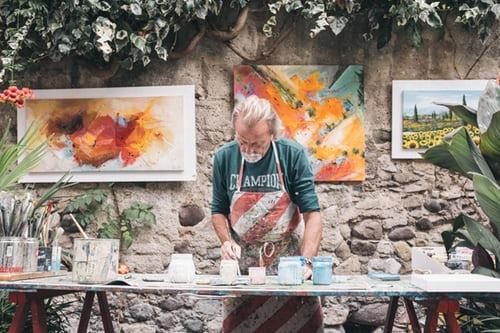Different Forms of Abstract Art 📰

While there are different types of abstract art, there is a general consensus that abstract art has no clear meaning or direction. Any thought, emotion, or recreation of a realist view is done through the use of different colors, lines, shapes, geometric patterns, symmetrical and non-symmetrical designs.
Read on to find out about the different forms of abstract art that have been used by abstract artists for centuries and have inspired the work of artists today.
The Basic Premise of Abstract Art
In abstract art, color takes precedence over shapes and the overall structure of the painting. The right colors make the artwork complete. In fact, abstract art has become a popular choice for interior design, where bright colored prints may be used to add some contrast to a monochrome room or dull shades may be used in brightly colored spaces.
The reason why abstract art is favored, not just for artists to create, but also for others to enjoy and as a pleasing view for patients is because it has a sense of eternal beauty. The Greek philosopher, Plato was among the many people who caught onto the ideology that unnatural images like geometric patterns and seemingly meaningless shapes and lines have a timeless charm. This is based on the fact that any kind of art, whether it’s abstract or realist starts out as color on a blank, one-dimensional canvas, and it’s color that brings this canvas to life.
Iconic Abstract Artists & Their Painting Style

The realm of abstract art has achieved its premium status in the art world based on the efforts of many of the following artists who took part in the abstract art movements that led to it being recognized as a credible art form:
Wassily Kandinsky
Kandinsky used his art to project his inner thoughts and feelings and used vibrant, intense colors that were a great contrast from any colors found in nature. He believed that he could explore his spirituality through his artwork.
Jackson Pollock
Pollock is the founder of the infamous drip technique where paint drips off a brush or from its container onto the canvas at the points where the artist holds the paint source allowing it flow on its own course.
Mark Rothko
Rothko’s approach to abstract art is quite unique. His paintings consisted of large colored masses without any sharp lines or edges. There was no obvious focal point or attraction in his work, but looking at his work had a spiritual effect on the viewers. The color choices and the way they were spread on the canvas, for the most part, portrayed much of his anxiety and sorrow, which was and is soaked in by all those who observe his art.
Robert Delaunay
Delaunay and his wife, Sonia Delaunay, are known as the founders of simultaneism (also referred to as Orphism) which is his interpretation of the cubist movement. The basic premise is the same as cubism but with the added construct that art should be read and interpreted the same way as a piece of music. While the cubist movement moved away from a focus on color, simultaneism makes it the pivotal part of the painting. His version of creating abstract art involved creating paintings that had a sense of harmony and rhyme, just like music lyrics.
Common Views of Abstract Art
The kind of art you create depends on what belief you hold in your mind before you hold a brush in your hand. Generally, abstract art falls into one of the following categories:
Emotional Art
This version of abstract art can be considered to be the closest to realist art where natural and real emotions and objects and views are depicted in a completely unnatural, abstract way. Van Gogh’s work can be considered to be emotionally abstract art where much of his work was inspired by what he felt of viewed at the moment, including his own self-portraits after he lost his ear.
Expressionist Art
While emotional art holds some semblance to reality, expressionism is rooted in letting out one’s emotions. Simply put, this is an artist’s version of penning down the thoughts in their head.
Gestural Art
Gestural art focuses more on the way it is painted rather than the final, complete outcome. The artist will convey their point of view depending on the type and direction of brush strokes (or through action painting such as the drip technique). For instance, short, straight strokes may show a sense of harmony, while wild and loose brush strokes may show chaos.
Geometric Art
Geometric abstraction gets much of its inspiration from cubism where straight, clean lines and patterns are the order of the day. Circles, squares, right angles and more may be used to give a lifelike effect. In fact, the aim of many such artists is to use cubism to give their work a more 3-dimensional effect like Picasso’s work that showed the same object from different angles on the same canvas.
Minimalist Art
This is a more modern form of abstract art where the artist simplifies the shapes, lines or patterns used as well as the general color palette. This kind of painting may not always have the emotional strength and may often be used just for its aesthetic value.
Why Abstract Art is Still Popular Today
Abstract art is valued, not just by artists but by everyone. The fact that it is completely open to individual interpretation and allows both the artist and the viewer to completely let go gives abstract art a soothing and comforting quality.
In fact, abstract art is now also created digitally using pretty much the same techniques as those applied to a canvas.
The therapeutic qualities of abstract art, the fact that there’s no “one right answer,” and that you never get tired of looking at the same piece of abstract artwork allows both the artist and the people looking at it to be completely free.












